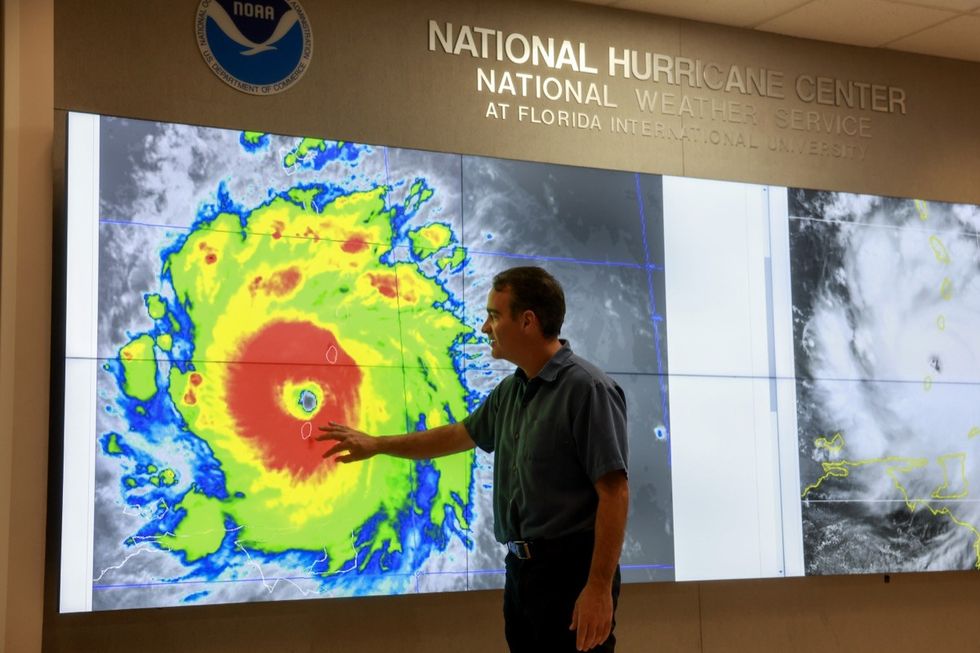Memorial Day Weekend marks the beginning of barbecue and rooftop happy hour season. But unfortunately, for folks living near and along the Atlantic Ocean, it also signals the start of hurricane season. Last year brought one of the deadliest hurricane seasons to ever rip through the U.S., leaving catastrophic damage in its wake. And 2025 could follow in its footsteps, warns the National Oceanic and Atmospheric Administration (NOAA). Here’s what you need to know to stay alert and safe as the hurricane season approaches.
RELATED: Meteorologists Issue Hurricane Season Warnings for Parts of U.S.: “Rapid Intensification of Storms”
NOAA 2025 outlook warns of three to five major hurricanes
The NOAA’s outlook for the 2025 Atlantic hurricane season is here and it doesn’t bear good news. Their predictions forecast a 60 percent chance of an “above-normal” season, 30 percent chance of a “near-normal” season, and only a 10 percent chance of a “below-normal” season. Climate change is partially to blame, due to the prevalence of warmer ocean temperatures.
So, what exactly does an “above-normal” hurricane season entail?
The NOAA is forecasting 13 to 19 total named storms, with winds exceeding 39 miles per hour. Of those, six to 10 are likely to develop into hurricanes with winds of 74 miles per hour or higher. It’s predicted that half of these (three to five) will get promoted to Category 3, 4, or 5 hurricanes.
The agency has a 70 percent confidence in these ranges.
“NOAA and the National Weather Service are using the most advanced weather models and cutting-edge hurricane tracking systems to provide Americans with real-time storm forecasts and warnings,” Commerce Secretary, Howard Lutnick, said in a statement. “With these models and forecasting tools, we have never been more prepared for hurricane season.”
Speaking with NBC News, meteorologist Ken Graham said now is the time to get prepared before Mother Nature strikes first.
“We’re really looking at an above normal season,” said Graham, who also serves as the director of the National Weather Service.
“It’s a good time to go out there and get your supplies and your kit and put it together,” he continued. “We’ve got to be ready. No lines for supplies today. No lines for gas, no lines for plywood, no lines for water.”
How the NOAA determines a hurricane’s category rating
The NOAA uses the Saffir-Simpson Hurricane Wind Scale to determine a tropical storm’s wind range and estimated potential property damage. “While all hurricanes produce life-threatening winds, hurricanes rated Category 3 and higher are known as major hurricanes,” explains the agency.
Here’s how the categories differ:
- Category 1: 74-95 mph winds that could result in some roof damage, fallen trees, and powerline damage.
- Category 2: 96-110 mph winds that could cause “extensive” damage, including major roof and siding damage, uprooted trees and roads, and near-total power loss.
- Category 3: 111-129 mph winds with “devastating” damage and loss of electricity.
- Category 4: 130-156 mph winds with “catastrophic” damage, including roof structure and exterior wall damage, uprooted trees, fallen power poles, and power outages.
- Category 5: 157 mp winds or higher with “catastrophic” damage, including total roof failure and collapsed walls, fallen trees and power poles, and power outages. Much of the area will likely be uninhabitable.
Why is this hurricane season expected to be worse than normal?
New Hurricane Is a Bad Omen of What’s to Come, Meteorologists Say—Here’s Why
Joe Raedle / Getty Images
Warmer than average ocean temperatures and reduced trade winds are mainly to blame for this season’s above-normal predictions. “The higher-heat content provides more energy to fuel storm development, while weaker winds allow the storms to develop without disruption,” explains the NOAA.
At the same time, tropical storm waves from the West African Monsoon could fuel a more active hurricane season in the Atlantic. The agency says this storm pattern is “a primary starting point for Atlantic hurricanes.”
“All of these elements tend to favor tropical storm formation,” the NOAA warns.
Here’s the official list of 2025 Atlantic hurricanes:
The NOAA has already released its list of Atlantic tropical cyclone names for the 2025 season. In alphabetical order, these include:
- Andrea
- Barry
- Chantal
- Dexter
- Erin
- Fernand
- Gabrielle
- Humberto
- Imelda
- Jerry
- Karen
- Lorenzo
- Melissa
- Nestor
- Olga
- Pablo
- Rebekah
- Sebastien
- Tanya
- Van
- Wendy
How to stay safe as hurricane season approaches
For the average American, especially those living in coastal or storm-prone areas, the best advice is to prepare early, stay informed, and have a plan.
You can check if you live in an evacuation zone or flood-prone area using tools like FEMA’s Flood Map Service Center. Even inland areas can face flash floods and power outages.
Next, sign up for local emergency alerts and monitor the NOAA’s Weather Radio, National Hurricane Center, and your city or county’s emergency management updates.
Prep your family by packing an emergency kit and planning exit strategies if you need to evacuate. Make sure everyone in your household knows how to reach each other and where to go if you’re separated. Pick an out-of-town contact person just in case.
If a hurricane hits your area and authorities are telling you to leave—go. Roads get congested fast, and staying behind can be life-threatening. Bottom line: Stay informed and vigilant.
Content shared from bestlifeonline.com.

